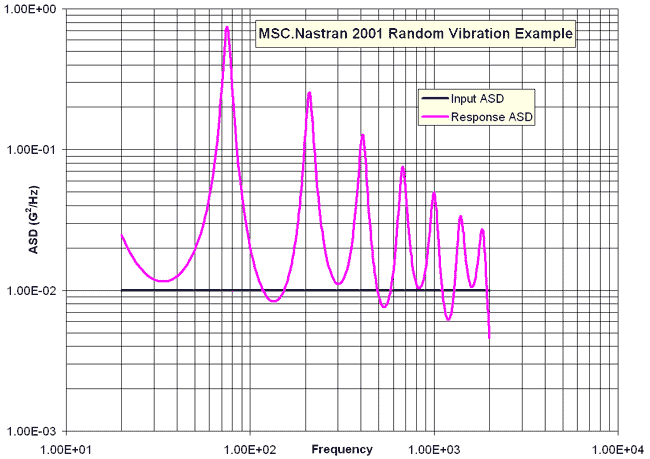


MSC.NASTRAN Random Vibration Example
Following is an example of an MSC.Nastran v. 2001 random vibration analysis run. All the NASTRAN cards necessary to perform a random run are described here. Comments follow the card (or cards) being described. The random-specific cards are in bold. The model is a simple cantilever beam with 48 elements and 49 nodes. It lies along the Y-axis with the first node, 101 at the origin. The downloadable data file can be found at the bottom of this page.
NOTE: This method will only work for MSC's version 2001 or later of NASTRAN because they (finally!) did away with the large mass needed to do frequency response runs. This method is extremely similar to UAI's version of frequency response runs. (See notes below for the differences.)
If you are using MSC/NASTRAN version 70.7 or earlier, then you still need to use the large mass. An example of this method is given on the Seismic Mass Frequency Response page.
Index:
ACCE | Bulk Data Deck | Case Control | DLOAD | Eigenvalue Output | EIGRL | ENDT | Example Plot | Executive Control | FREQ | FREQ1 | FREQ3 | INCLUDE | METHOD | Output Summary | OUTPUT(XYPLOT) | PSDF | Punch Output | RANDOM | Random Output | RANDPS | RESVEC | RLOAD2 | RMS Values | SDAMPING | Shaker Point | SOL | SPC | SPC1 | SPCD | SPCFORCES | TABDMP1 | TABLED1 | TABRND1 |
XYPEAK | XYPLOT | XYPUNCH
Input Data Deck
$EXECUTIVE CONTROL DECK ID BEAM,RANDOM SOL 111
Modal Frequency Response Solution Number
$ TIME 10 CEND $ $CASE CONTROL DECK TITLE = RANDOM VIBRATION EXAMPLE MODEL SUBTITLE = 48-ELEMENT CANTILEVER BEAM ON THE X-AXIS LABEL = Y-DIRECTION RANDOM INPUT OF 0.01 G^2/HZ FROM 20-2000HZ $ Beam is along the X-axis and is 48 inches long $ SPC = 1 METHOD = 1 DLOAD = 10 SDAMPING = 20 RANDOM = 30 FREQ = 40
SPC refers only to the SPC1 card (not the SPCD card);
METHOD refers to EIGR card;
DLOAD refers to RLOADx card;
SDAMPING refers to TABDMP1 card;
RANDOM refers to RANDPS card;
FREQ refers to all FREQx cards used
$ ECHO = NONE $ $SET 99 = 101 $SPCFORCES(PHASE) = 99
The preceding two cards are used for shaker point force recovery only (remove $ if needed).
SET 99 sets the shaker GRID 101 output;
SPCFORCES requests force recovery at SET 99 (see OUTPUT and SPCD cards below)
$ OUTPUT(XYPLOT) XYPEAK,XYPUNCH,ACCE,PSDF/ 101(T2),149(T2)
Cards used for plot output.
NOTE: THIS IS THE ONLY WAY TO GET RANDOM OUTPUT!
OUTPUT card is required to use XYPLOT commands;
XYPEAK recovers RMS and other peak responses in the .prt file (required for RMS output);
XYPUNCH creates a .pch file of response vs. frequency;
ACCE requests acceleration output (FORCE requests force output);
PSDF requests output as PSD;
GRID point 101 and 149 responses recovered; T1=X, T2=Y, T3=Z, as well as R1, R2, and R3
$ BEGIN BULK $ PARAM,AUTOSPC,YES PARAM,GRDPNT,0 PARAM,RESVEC,YES
PARAM,RESVEC,YES is REQUIRED for accurate results when NOT using the seismic mass. It computes residual vectors.
$ GRID 101 0 0. 0. 0. 0
Shaker grid point. Often this is an RBE element attached to many GRID points with the independent GRID being the shaker point.
$ SPC1 1 123456 101
The Shaker point is SPC’d in all DOF
$ RLOAD2,10,11,,,12,,ACCE
RLOAD defines frequency response dynamic loading;
LOAD = SPCD * TABLED1 [= A * B(f)];
11 IS SPCD card;
12 IS TABLED1 card;
ACCE refers to type of dynamic excitation, enforced acceleration in this case. Other options are LOAD for applied load, DISP for enforced displacement, and VELO for enforced velocity.
$ SPCD,11,101,2,1.0
Y-axis input at GRID 101;
2 refers to input direction (1=X, 2=Y, 3=Z);
1.0 is any scale factor;
$ $SPCD,11,101,2,386.4
Use this card instead when recovering forces or displacements (assuming you're using the inch/pound system), such as at the shaker point. If you're using a metric based system, such as mm/gram, then 386.4 becomes 9807. (You can also change the 1.0 values in the TABLED1 card below to the acceleration value and get the same result. But do not change both.)
$ TABLED1 12 LOG LOG + + 20.0 1.0 2000.0 1.0 ENDT
TABLED1 is a tabular function defining the frequency-dependent portion of RLOAD2
The table is given as X1,Y1, X2,Y2, X3,Y3, etc.;
20.0 is the beginning frequency (X1); 1.0 is the magnitude (Y1);
2000.0 is the ending frequency (X2); 1.0 is the magnitude (Y2);
The Y values are used as scale factors; the actual Y values are entered as random input in TABRND1 below (not frequency input);
The LOG LOG entries refer to how the data is interpolated on each axis.
NOTE: All tables MUST end with an ENDT card.
Also, tables are not always compatible between UAI/NASTRAN and MSC/NASTRAN. The tables used in the older version of this example would not work under Nastran 2001.
$ TABDMP1 20 + + 20.0 0.1 2000.0 0.1 ENDT
Defines modal damping of Q=10;
The damping is 1/Q over the range of frequencies; in this case Q is constant. Q can vary over frequency if the proper data is available.
$ RANDPS,30,1,1,1.0,0.0,31
Defines random PSDF loading;
The important value here is the 31, which refers to the TABRND1 card
$ TABRND1 31 LOG LOG + + 19.999 0.01 20.0 0.01 2000.0 0.01 2000.1 0.01+ + ENDT
Defines PSDF from 20 to 2000 Hz on a log-log scale;
First value must be slightly lower than actual frequency;
Format is Frequency, PSD,
Final value must be slightly higher than actual frequency
$ FREQ1,40,20.0,2.0,140 FREQ1,40,300.0,5.0,140 FREQ1,40,1000.0,20.0,50 FREQ3,40,20.0,2000.0
FREQx cards input frequencies where responses are recorded;
FREQ1 gives beginning frequency, freq. increment size and number of increments;
FREQ3 adds each natural frequency FROM 20 TO 2000 Hz
$ EIGRL 1 0. 2000. 0 MASS
EIGRL determines normal modes from 0 to 2000 Hz
$ INCLUDE 'randbulk.dat'
Bulk Data can be elsewhere in a different file.
$ ENDDATA
